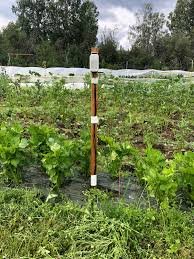
In the vast and frozen landscapes of the North,lies a hidden world of ancient knowledge and enduring life. Permafrost, the frozen realm beneath the earth’s surface, holds secrets that have shaped the lives of Arctic peoples for centuries. As the Arctic warms and human activities increase, unlocking the wisdom of permafrost is crucial to ensure the sustainability of northern agriculture, a vital lifeline for communities and ecosystems alike. Embark on a journey into the frozen depths, where time seems to stand still and knowledge whispers from the soil, guiding us towards a harmonious coexistence with the fragile landscapes of the North.
– Permafrost Forecasting: Addressing Agricultural Challenges in the North
The cornerstone of sustainable agriculture lies within a comprehensive understanding of ecological processes and their intricate interplay with climatic conditions. In northern regions characterized by permafrost landscapes, this understanding becomes paramount, as permafrost dynamics substantially influence agricultural practices and the viability of plant life. As such, a profound understanding of permafrost behavior and its forecast is critical to supporting the sustained growth and prosperity of northern agricultural ecosystems. It enables farmers to make informed decisions regarding crop selection, planting schedules, and infrastructure progress, empowering them to mitigate potential risks associated with permafrost degradation and permafrost thaw-induced environmental changes. Embracing permafrost forecasting empowers agriculturalists with the knowledge to navigate the complexities of northern environments,optimizing their practices to align with the ever-evolving landscape and ensuring the long-term productivity of their endeavors.
– Sustainable Land Use Practices: Balancing Agriculture with Permafrost Conservation
Importance of Permafrost Knowledge for Northern Agriculture
Understanding and preserving permafrost is crucial for balancing agricultural practices with the conservation of this sensitive arctic ecosystem. Permafrost, found in regions with subfreezing temperatures for long periods, contains frozen soil, ice, and organic matter. Its stability is essential for maintaining the delicate ecological balance of the region. Sustainable agricultural practices must consider the potential impacts on permafrost, such as:
Thawing: Agricultural activities that involve heating or disturbing the soil can lead to permafrost thawing, releasing greenhouse gases and destabilizing landscapes.
Erosion: Thawing permafrost weakens the soil structure, increasing the risk of erosion and loss of fertile topsoil.
* Alteration of hydrology: Modified drainage patterns due to permafrost degradation can affect water availability and negatively impact downstream ecosystems.
– Permafrost Monitoring and Sensing: Enabling Data-Driven Management
Ground ice within permafrost regions impacts agricultural development. Permafrost temperatures, presence or absence of frozen ground, ice content, and thaw depth are all factors that influence soil properties relevant to crop production. Monitoring these characteristics can definately help farmers make informed decisions about where and when to plant. In addition, long-term permafrost monitoring datasets, maintained by organizations such as the National Snow and Ice Data Center, provide a wealth of past data that can help scientists understand the impacts of climate change on northern permafrost landscapes, and thus help agricultural stakeholders predict future environmental conditions and agriculture suitability.
– Policy and Adaptation: Integrating Permafrost Considerations into Northern Agriculture
Knowledge Gap Hinders Northern Agricultural Sustainability
The article also pointed toward the lack of permafrost knowledge among decision-makers across the region. Among 287 international respondents from 8 northern jurisdictions,the results showed that respondents from jurisdictions with strong permafrost knowledge were “significantly more likely to indicate institutional capacity to address permafrost in land-use planning.” The study concluded that permafrost knowledge is crucial for “supporting decision-makers seeking to strengthen the sustainability of northern agriculture facing permafrost degradation.”
| Jurisdiction | “Permafrost knowledge influenced institutional capacity” |
| — | — |
| Northwest Territories | 84% |
| Alaska | 82% |
| Inuvialuit Settlement Region | 77% |
| Norway | 84% |
| Finland | 81% |
| Greenland | 55% |
| Siberia, Russia | 46% |
| Yukon | 63% |
To Wrap It Up
As the icy embrace of permafrost thaws, revealing the secrets held captive beneath for millennia, we must harness this newly unearthed wisdom to cultivate a sustainable agricultural legacy in the far north. By embracing the lessons of permafrost, we can unlock a wealth of knowledge and ingenuity that will guide us toward a future where food security and environmental preservation go hand in hand.